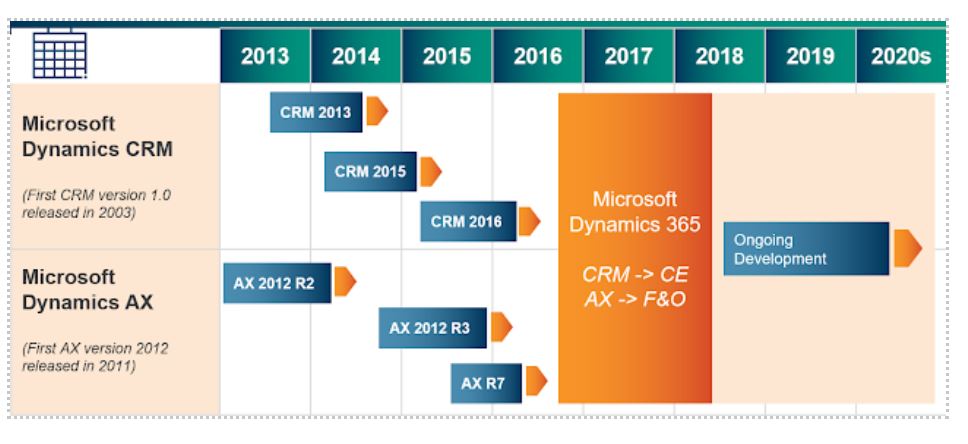Microsoft Dynamics 365 is the only portfolio of intelligent business applications that empowers everyone to deliver operational excellence and create more engaging customer experiences.
Microsoft, always a pioneer, was one of the first to combine those capabilities natively. The platform includes more than a dozen apps and add-ons addressing various needs of organizations.
For starters, questions remain: Is Dynamics 365 the same as Dynamics CRM? What happens to Dynamics AX? Let’s look back in time to understand the evolution of the product family.
The Microsoft Business Solutions division was launched in the early 2000s to develop Microsoft’s very own business suites of applications. This was made possible by the previous acquisitions of business management products which formed the building blocks for the Dynamics family. In 2003, Dynamics CRM version 1.0 was born.
The research and development effort on the Dynamics product family was coming into focus in 2006 with the rebranding of the Microsoft Business Solutions Division into Microsoft Dynamics, with the following product lines:
- Dynamics AX
- Dynamics CRM
- Dynamics GP
- Dynamics NAV
- Dynamics SL

Dynamics CRM version 4.0 was released in late 2007 and marked the first time the product received significant adoption in the market. A cloud hosting option (i.e., Dynamics CRM Online) and multi-tenancy were introduced, paving the way for a more flexible and accessible future. Customers no longer needed to deal with local hosting maintenance.
Hot on the heels of Dynamics CRM 4.0, the release of Dynamics CRM version 2011 in February 2011 continued the product momentum with improved user interface, and a new agile approach on a bi-annual update schedule. This allows for faster development and more innovation than the traditional two- to three-year schedule for business software. Subsequent releases of Dynamics CRM version 2013, 2015 and 2016 in the years that followed injected new features into the platform. Although the product was centered in traditional CRM components such as sales, service and marketing, organizations adopted the product for its high customization and scalability to fit non-traditional CRM business scenarios. Organizations saw the benefits of using Dynamics CRM as an “xRM” (Anything Relationship Management – the concept of modifying the existing capabilities and services of the CRM system to quickly create a customized line of business applications) solution platform.
As Dynamics CRM continued to gain traction in the market, so did Dynamics AX – Microsoft’s ERP product. However, a constant challenge remained for integrating the two applications seamlessly to meet the wholistic enterprise needs of customers.
A new era arrived in late 2016, when what we recognize today as Dynamics 365 was born. Dynamics CRM and Dynamics AX were essentially replaced, and their capabilities merged into the new Dynamics 365 platform on a common data model. Furthermore, Dynamics 365 became a true modular platform, with its capabilities broken down into several apps, so that users could start with only what they needed and grow at their own pace, adding new functionalities as and when they need them. Dynamics 365 officially became the successor of Dynamics CRM and Dynamics AX. Dynamics 365 has moved beyond CRM and ERP to be an application platform for business processes. From a CRM perspective, organizations are no longer limited to sales, service and marketing. There is now a true cross-industry, cross-process platform.
The CRM capabilities of Dynamics 365 is now a solution widely known as Dynamics 365 Customer Engagement, or simply Dynamics 365 CE, and includes the following key suites of applications:
- Dynamics 365 Sales
- Dynamics 365 Customer Service
- Dynamics 365 Marketing
- Dynamics 365 Field Service
- Dynamics 365 Customer Insights
- Dynamics 365 Customer Voice
The ERP capabilities of Dynamics 365 is now widely known as Dynamics 365 Finance and Operations, or simply Dynamics 365 F&O, and include the following key suites of applications:
- Dynamics 365 Finance
- Dynamics 365 Supply Chain Management
- Dynamics 365 Commerce
- Dynamics 365 Project Operations
- Dynamics 365 Human Resources
- Dynamics 365 Fraud Protection
The underlying data model of Dynamics 365 CE was rebranded from Common Data Service (CDS) to Dataverse. With native integration with the Microsoft Power Platform, the applications can be further extended by the Power Apps, Portal, Power Automate, Power Virtual Agent and Power BI.
It’s an exciting time for Dynamics 365!
To learn more about our Microsoft Dynamics 365 Services, visit Protiviti.com/Microsoft.



